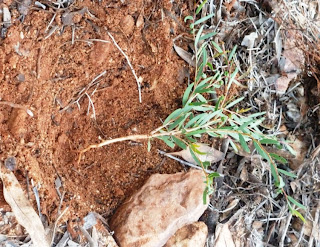Media coverage has been all over the supposed rat plague besieging Alice Springs this week. This is all very exciting but has twisted the story a bit and missed the most interesting parts.
Firstly, these are not feral rats, but native rats. Feral rats are very rarely recorded in Alice Springs and are usually the result of deliberate releases of unwanted pets - these animals don't last long in our climate. Secondly, a grand total of 6 animals have so far been identified which hardly constitutes a plague. It seems that we will certainly see more of these animals around town in the next few weeks, but we are a long way from surrendering the town and calling in The Pied Piper.
The animal that has everyone talking is the
Long-haired Rat, Rattus villosissimus. This animal is known colloquially as a plague rat because of its ability to reproduce very rapidly during good seasons and spread out across the country to areas where it may not have been seen for decades. A female Long-haired Rat can produce 12 young every three weeks in good conditions.
This animal is usually rare, even in its core range on the cracking black soil plains of the Barkly Tablelands and further south in cracking soils along the eastern fringes of the Simpson Desert, and probably also in parts of the Tanami Desert. Its appearance is often followed by population increases in the Letter-winged Kite,
Elanus scriptus, and Inland Taipan,
Oxyuranus microlepidotus. Both of these animals share a similar pattern of population boom and bust and maintain core populations in similar areas to the Long-haired Rat. Letter-winged Kites and Inland Taipans both have adaptations to make the Long-haired Rat the main part of their diet.
The Letter-winged Kite is the only predominantly nocturnal hunter among the other raptor species in its family. It has large dark markings around its eyes which aid its vision on moonless desert nights in search of the nocturnal Long-haired Rat. These markings even give the Letter-winged Kite a vaguely owl-like aspect even though it is not closely related to the actual owls (Strigidae).
The Inland Taipan is perhaps best known as having the most toxic venom of any terrestrial snake on earth. It may have evolved this in response to the Long-haired Rat's impressive choppers. Anyone who has ever had to handle a Long-haired Rat, and been bitten, will testify to their gnawing ability. Snakes (and most reptiles) have a slower metabolism than mammals and can be very susceptible to infection of any open wounds as they take longer to heal. The typical elapid (front-fanged snakes) technique of striking
and constricting their prey might be disadvantageous if the snake was spending most of its time hunting Long-haired Rats. The inevitable gnawing suffered while waiting for venom and asphyxiation to take effect would take a devastating toll. So the Inland Taipan has developed a unique
strike and retreat method of hunting. To make this technique viable it has had to evolve a venom so potent that its prey will be immediately immobilised. The snake can then observe the prey from nearby until it is quite sure it is safe to approach without fear of being chomped by those great teeth.
So what we are witnessing here in Alice Springs is the very pulsing of the boom and bust natural economy of our deserts in action. These rats have not been seen in Alice Springs for around 25 years and they will probably not be around for long. As sure as the rats are breeding up and spreading, so are the kites and the taipans. While it is unlikely that Inland Taipans would make it as far as Alice Springs, people down around Oodnadatta and Coober Pedy might start seeing a few more as the season progresses. The Inland Taipan's other trick is its ability to remain active right through the cold desert winter. It manages this through some impressive adaptations in its vascular system, but that is a story for another time.
The Letter-winged Kites will almost certainly be seen around The Centre in due course. As the rats make their way here, the kites will follow.
Soon enough, the rat population will dwindle, the taipans will retreat back into deep cracks in the earth, and the kites will return to their stronghold colonies out in the desert. We may not see any of these animals in such numbers again for another 25 years or more.







